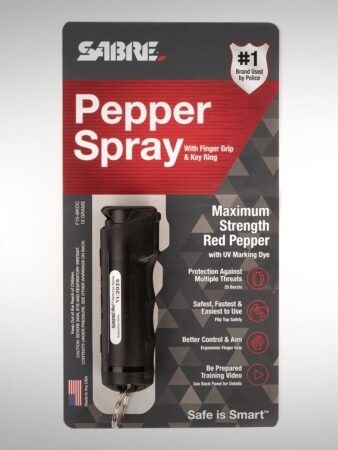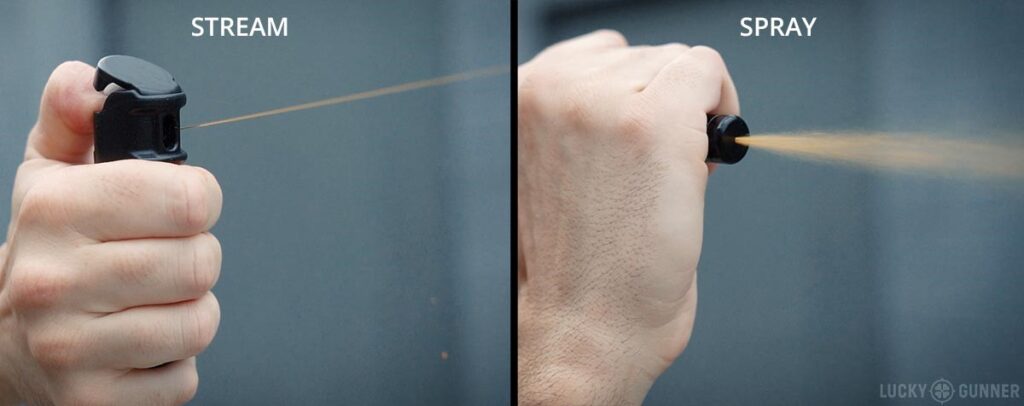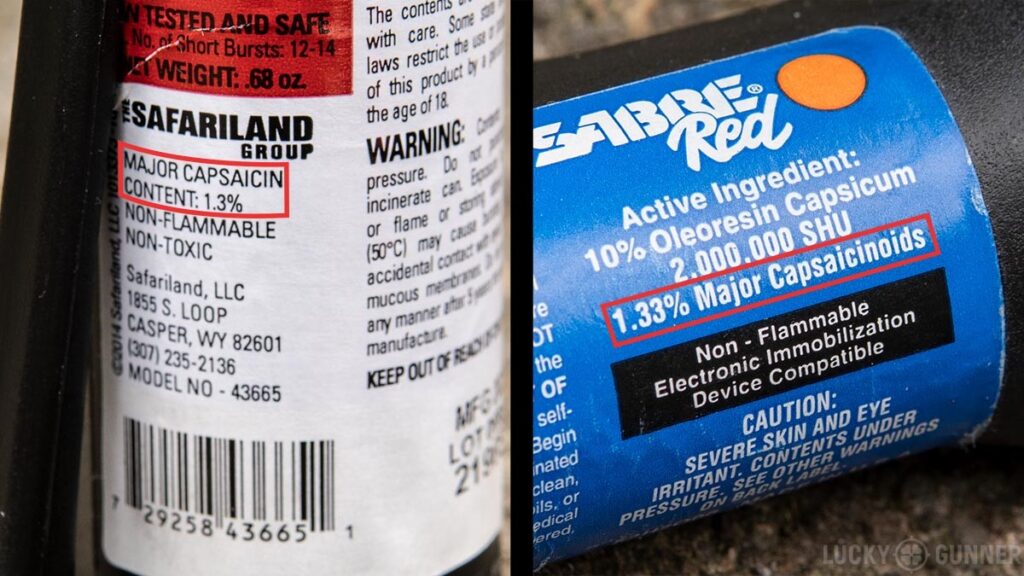Article attributed to Chris Baker, Lucky Gunner
Note: The product assessment for this article will be based on the SABRE pepper spray product line. SABRE is a leader in pepper spray manufacturing and application training.
If you carry a gun, I think you should seriously consider also carrying pepper spray. Even if you don’t carry a gun, you should consider pepper spray. That’s what we’re going to talk about today: pepper spray, also known as oleoresin capsicum, or “OC” for short.
There are a lot of myths and misconceptions out there about OC. I could spend this whole video trying to dispel those myths. I would love to go really deep into the why, when, and how to use pepper spray. But I’m not going to do that today because fortunately, that stuff has already been covered in great detail by other people, and they’ve done a fantastic job. So I’m going to link to those resources below.
I will quickly cover some of the basics, but I’m going to spend most of this video reviewing different pepper spray products. I’ve got a dozen of them here. No, I’m not doing any exposure testing in this one. I love you guys, but not that much. But I did test spray each one at a target so we can see how far they go and how long they last. We’re also going to look at what type of OC is in each product, the activation mechanism, the type of pattern they have. And I’ll talk about what to look for in a quality OC for your everyday carry.

Why Carry Pepper Spray?
Okay, so “why pepper spray? I thought this guy usually talked about guns.” I carry both a gun and pepper spray on a daily basis and I think the pepper spray is probably the more useful item. I honestly can’t remember how I initially got into the habit, but I’m pretty sure Chuck Haggard was at least partly responsible. Chuck is the owner of Agile Tactical Training and a retired police lieutenant from Topeka, KS. Over the last few years, he’s done more than anyone else to educate the firearms training world about the benefits of carrying OC.
During his time in law enforcement, Chuck’s conservative estimate is that he has used OC on suspects in the field around 300 to 400 times and on trainees around 1500 times. He has personally been exposed to OC well over 60 times. If anybody knows what pepper spray is capable of, it’s Chuck Haggard. He also teaches open-enrollment pepper spray classes. I had the opportunity to take his OC instructor course a couple of years ago. I highly recommend that or any of his OC seminars if you get the chance. A lot of the most important, basic “need to know” stuff is available in articles Chuck has written and some video clips of his lectures on YouTube. Again, I’ll link to those below.
The quick elevator pitch for OC is that it gives you a force option that’s somewhere between harsh language and shooting somebody. We all know that statistically, we are very unlikely to end up in a situation where we need to use our firearm to defend our life. Much more common are situations that call for some kind of intervention that’s less than deadly force. Maybe someone is behaving in a threatening way, but they don’t have a weapon and they have not done anything yet that would warrant using deadly force. That might be a good time to deploy some OC.
It’s not magic. OC is not a substitute for a deadly force option. It doesn’t work 100% of the time. But it’s a force response we can use early in an encounter to hopefully stop everything or get away from that person before the situation escalates. Using a non-lethal option sooner means we don’t have to resort to the lethal option later. And if we mess up and spray someone who didn’t really deserve it, the consequences are far less severe. Nobody dies, nobody goes to prison.

What is OC and What Does it Do?
OC is essentially a chemical inflammatory agent extracted from the oils of certain chili peppers. It causes a severe burning sensation on the skin. If it gets in and around the eyes, they will swell up and most people will involuntarily close their eyes. If it gets in the nose and mouth, it usually causes severe coughing and shortness of breath.
Unless they are in some kind of altered mental state or have trained to fight through it, people who are hit in the face with high quality pepper spray tend to stop doing whatever they were doing. It also works really well on animals like dogs and bears.
The OC formulas that are used by the major manufacturers today are not known to have any long-term health effects. It’s a very safe product. For most people, the worst of the effects will pass in about an hour.
Compare that to wasp and hornet spray, which has little to no short term effect on humans, but definitely can cause serious long-term health problems. It’s basically the opposite of what we want in a non-lethal force option. Pepper spray is cheap and readily available. There is literally no reason to rely on wasp and hornet spray for self-defense.
Of course, just like a firearm, the efficacy of pepper spray is partly dependent on the delivery mechanism. So let’s look at our twelve pepper spray devices. Some of them are good. Some of them are kind of gimmicky and not so good.


SABRE Stream Flip Top
I’ll start with one of the good ones. This one is a SABRE brand product. It comes in a key chain style dispenser with a springy flip top safety.
You have to really pay attention to the packaging on these things. They will often use the same dispensers for different products. You might even see multiple companies using the same dispenser for different products. It doesn’t mean the OC inside is the same.
For example, SABRE uses this dispenser for their standard stream OC, for their gel, and for their 3-in-1 product. The dispenser comes in several different colors and the color doesn’t indicate what’s in it. This one contains the standard SABRE Red OC that fires in a stream. It also has a UV marking dye that supposedly helps the police identify the suspect later on. I’d be really surprised if that ever actually happens, but it doesn’t hurt for it to be in there.
You have to read the fine print on the back really carefully to learn that this one is actually a stream and not a spray. It says spray really big on the front, but that’s kind of misleading. A stream is like a laser where a spray is more like a flashlight beam.
A stream is not as likely to get blown off target or back in your face as a spray. The spray has the advantage of creating a cloud of OC that more often causes those respiratory effects. With a spray, you’ve got a better chance of getting at least some OC on the target, but you’re probably going to get at least a little back on yourself. You can also use a spray to create a kind of barrier cloud that hangs in the air. An attacker would have to go through that to get to you while you’re retreating. Spray and stream both have their place, just make sure you know what you’re getting.
You should also know that OC that’s marketed for self-defense is pretty much completely unregulated. The manufacturers can make whatever claims they want on the package and no one’s going to call them on it if it’s completely made up. So brand name is really important. The OC used in SABRE’s products is generally considered one of the best and most consistent. That doesn’t mean that every SABRE product uses a good dispenser, it just means the OC itself is generally good. Most of the products I’m testing today use the SABRE Red OC formula.
When you’re looking at labels, you shouldn’t get too wrapped up in Scoville Heat Units or percentage of OC that’s in the product. Those are not great indicators of effectiveness anyway. If you want some kind of number, look for the percentage of major capsaicinoids or MC. You want something between about .7% and 2% MC. The SABRE Red formula is 1.33% and most of the good OC has a similar potency.
Most of these units are activated by pressing down a switch on the top. It’s best to use your thumb for that. You can get a nice firm grip on it that way. If you hold it like a can of Lysol and activate it with your index finger, you’re not going to have a very strong grip on the unit. You’re also probably going to point the thing low.
According to the package for this flip top stream dispenser, we’ve got 15 grams of product here. Some of these are measured in grams and some of them use ounces. I’m not sure why. It says the effective range is ten feet and you should be able to get 25 bursts out of it. They don’t say how long a burst is, but let’s assume it’s about a half second. So if I just spray all of this at once, it should last for about 10 to 12 seconds before it’s empty.
For our test, I looked at the maximum effective range claimed by the manufacturer for each product. Then I got my friend Kaarl, the 3D dummy target to stand that distance away from me. The black marks on the building there indicate feet. SABRE claims this one is effective up to 10 feet. The camera makes it look like he’s way behind the 10 foot mark, but he’s actually right in line with it.
Unfortunately, the camera doesn’t pick up the actual stream very well. But looking at the target closeup, you can see that at 10 feet, I’m just barely able to get a few drops in his face. The stream really starts to dissipate at about 7 or 8 feet. I think 10 feet is pretty optimistic. But I did get a solid 10 seconds out of it. The package said 25 bursts. You could get 25 if each burst was .4 seconds, so that seems like a reasonable claim.
And this was pretty typical for almost all of the products I tested. The number of bursts or duration claimed by the manufacturer was pretty much spot on. The effective range was maybe two or three feet longer than I would be comfortable with. At around 5-8 feet, the SABRE flip top streamer should do exactly what we want a pocket OC unit to do.

